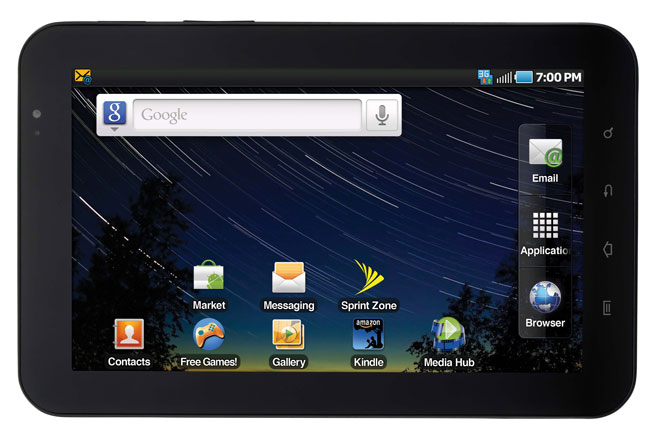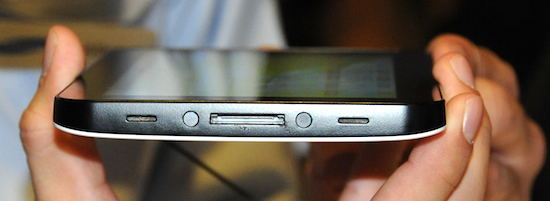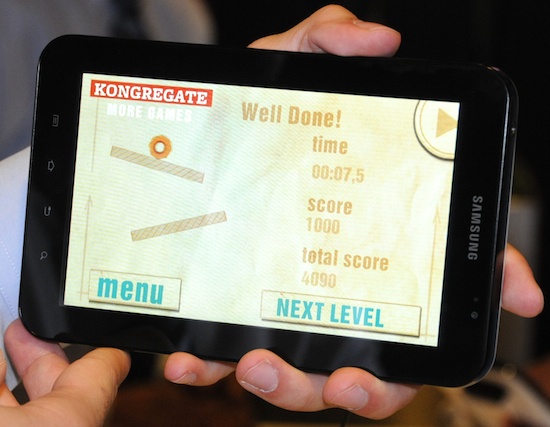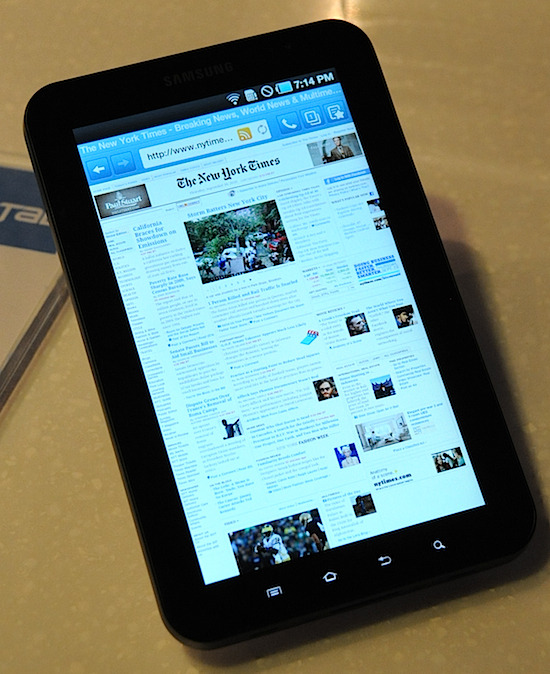“Samsung's new Galaxy Tab challenges the iPad with a smaller, Android-powered design, but comes up short on value, and feels like a supersized phone without the phone.”
- Fits in an inside jacket pocket
- 7-inch screen has perfect aspect ratio for widescreen movies
- Android 2.2 Froyo OS
- Long battery life
- Snappy Web browsing
- Poor 3.2 MP camera with no zoom, HD video recording
- Little Android optimization for larger screen
- No Wi-Fi-only versions available
- Screen washes out at off angles
- Proprietary dock connector instead of microUSB
- Overpriced

Features and Design
As you no doubt know by now, the Samsung Galaxy Tab has a 7-inch, 1024 x 600 pixel screen. It runs Android 2.2 Froyo OS, and shares the same Cortex A8 1 GHz Hummingbird processor powering Samsung’s Galaxy smartphones. It’s got 2GB internal memory, and the Sprint version (the one we reviewed) comes with a 16GB microSD card pre-installed. It’s equipped with 802.11 b/g/n, Bluetooth 3.0, the Sprint mobile hotspot that can support up to five Wi-Fi users, and, disappointingly, a proprietary iPhone-like jack rather than a microUSB connector.

Up front is a 1.3 MP camera for QIK video chatting, a 3-megapixel sensor with a single LED flash on the white plastic on the rear. Notably, all Android tablets will also support Adobe Flash. Currently, only combined 3G/Wi-Fi versions are available, although Samsung has indicated a Wi-Fi-only Tab will be available at some point.

The Tab also will fit in the thigh pockets of a pair of cargo pants, as well as the rear pocket of any pair of slacks or jeans. We would only trust it in deep cargo pockets, though, and even then, the Tab will slap your thighs (not in a good way), while walking. As for rear pockets, do you really want to take the chance of accidentally sitting on your Tab?
The Tab is a slippery devil; you have to be careful removing and replacing it in a pocket. It cries out for a case, but any added protection short of a Wrapsol or other clear plastic wrap and Tab would no longer fit in the aforementioned pockets, which could be a problem.
Multimedia capabilities
Here’s where the Tab nearly matches the iPad.
Its screen is a long 1024 x 600, nearly the exact aspect ratio as most widescreen movies. The iPad’s 1024 x 768 pixel, 9.7-inch screen, however, is less oblong, so widescreen movies are displayed letterboxed. As a result, despite its screen being three inches smaller, widescreen movies on the Tab are nearly the same size as they are on the iPad (extra credit if you can identify what film the still image in the comparative picture is from).

The Tab’s problem when compared to iPad is a narrower screen viewing angle. If you’re off around 45 degrees, the Tab’s screen starts to polarize, while the iPad’s remains clearly watchable.
Because it can fit in your pocket, the Tab actually works better as a music player than the iPad, which has to be carried in a bag or backpack. The problem is, no one yet makes Android-specific earphones with inline controls, which means you’ll be constantly lifting it from your pocket to pause or skip tracks.
Functionality
The Tab operates exactly like an Android phone, only larger, without the phone, of course, and with only three home pages. There are about 60 or so Tab-optimized

The biggest functionality issue that springs from the Tab’s size between smartphone and a larger tablet is its touch keyboard. In portrait mode, you can comfortably thumb tap, even more comfortably than on even a 4-inch smartphone touch keyboard. That means e-mail (and since Tab runs Froyo you get a convenient unified in-box) is a joy to check and answer correspondence. But the Tab is too wide in landscape mode to thumb tap, and without some sort of angled case, it’s hard to touch-type or hunt-and-peck when lying flat. While fine for occasional e-mail or messaging correspondence, the Tab is not the laptop replacement for extensive e-mail upkeep that the iPad is.
As you can see from the other iPad comparative pictures, you simply get a lot less on the Tab’s screen.
Web browsing

The Tab’s long and skinny screen may work fine for movie watching, but this shape works against it for nearly every other application, especially Web surfing.
For one thing, the Android browser thinks the Tab is a smartphone, so it automatically accesses mobile-optimized versions of sites such as The New York Times, CNN and ESPN, rather than either the full or iPad-optimized sites. While its long screen gives you a nice long list of headlines and the perfect column width for reading articles, it’s not taller than the iPad is in landscape mode. And in landscape orientation, the Tab is pretty much useless for Web browsing, just like smaller smartphones.
Even though the iPad’s pixel density of 132 pixels per inch is not as technically dense as the Tab’s 169, text on the Tab seems less distinct than on the iPad.
Access is snappy, though, at least for the aforementioned mobile-optimized sites, which leap fully loaded in two or three seconds. Non-optimized pages, however, take a sluggish 20 to 25 seconds to load.
Camera
The iPad has no camera, so the Tab seemingly has a leg-up for the time being. (Indications are strong both front and rear cameras will be included on the iPad 2, likely due in the early spring.)
But, the Tab is too large and awkward to wield as a snap-and-shoot camera, even with its giant viewfinder. Even when you manage to frame the right shot, the underwhelming 3.2-megapixel imager has a slow shutter, there is no zoom, and doesn’t take good pictures. Outside images and the 480p video are hazy, often bleached and mostly lack color, contrast and detail. All conditions improve slightly on inside shots, but results are still less impressive than from the higher-resolution cameras on Samsung’s Galaxy smartphones.
<span class=”mceItemObject” classid=”clsid:D27CDB6E-AE6D-11cf-96B8-444553540000″ id=”ooyalaPlayer_9kyoq_ggv1hyzj” width=”650″ height=”433″ codebase=”http://fpdownload.macromedia.com/get/flashplayer/current/swflash.cab”><span name=”movie” value=”http://player.ooyala.com/player.swf?embedCode=J3eGp1MTrEcVfqfLBRwoVTgqhjjIMtXy&#038;version=2″ class=”mceItemParam”></span><span name=”bgcolor” value=”#000000″ class=”mceItemParam”></span><span name=”allowScriptAccess” value=”always” class=”mceItemParam”></span><span name=”allowFullScreen” value=”true” class=”mceItemParam”></span><span name=”flashvars” value=”embedType=noscriptObjectTag&#038;embedCode=J3eGp1MTrEcVfqfLBRwoVTgqhjjIMtXy” class=”mceItemParam”></span><span class=”mceItemEmbed” src=”http://player.ooyala.com/player.swf?embedCode=J3eGp1MTrEcVfqfLBRwoVTgqhjjIMtXy&#038;version=2″ bgcolor=”#000000″ width=”650″ height=”433″ name=”ooyalaPlayer_9kyoq_ggv1hyzj” align=”middle” play=”true” loop=”false” allowscriptaccess=”always” allowfullscreen=”true” type=”application/x-shockwave-flash” flashvars=”&#038;embedCode=J3eGp1MTrEcVfqfLBRwoVTgqhjjIMtXy” pluginspage=”http://www.adobe.com/go/getflashplayer”></span></span>
Battery Life
Sprint says the Galaxy Tab will run for 13 hours of “active” use, but that number is almost useless since different functions, especially Web surfing via either the 3G network or via Wi-Fi, suck power at different rates. But 13 hours is longer than the 10 hours Apple rates the iPad for video playback.
Unlike a cellphone, which constantly seeks out a cell signal, sucking battery life, the Tab burns its static battery only when you’re actually using a wireless connection. As a result, the Tab can go days between recharges, which means it makes an excellent, long-lived e-reader.
Conclusion
Price will be an important consideration and, quite frankly, the Tab is too expensive. Samsung sets the price at $649 for the version with the 16GB card preinstalled (although each carrier is setting their own prices) – and that’s too high. You’re essentially paying for its portability rather than its functionality. Bottom line: If you already own a smartphone with a screen 3.5 inches or larger, especially a Galaxy
Highs:
- Fits in an inside jacket pocket
- 7-inch screen has perfect aspect ratio for widescreen movies
- Android 2.2 Froyo OS
- Long battery life
- Snappy Web browsing
Lows:
- Poor 3.2 MP camera with no zoom, HD video recording
- Little Android optimization for larger screen
- No Wi-Fi-only versions available
- Screen washes out at off angles
- Proprietary dock connector instead of microUSB
- Overpriced
Editors' Recommendations
- Samsung Galaxy Ring: news, rumored price, release date, and more
- The 20 best Samsung Galaxy Watch faces you should be using
- Samsung’s Galaxy AI is about to get a lot more useful
- Best Samsung Galaxy deals: S24, Buds, Watches and more
- Have a Samsung Galaxy S23? Don’t update your phone to One UI 6.1


